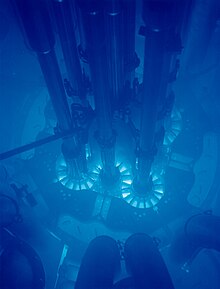Cherenkov radiation
The "Scots" that wis uised in this airticle wis written bi a body that haesna a guid grip on the leid. Please mak this airticle mair better gin ye can. (December 2020) |
Cherenkov radiation, forby kent as Vavilov–Cherenkov radiation,[a] is electromagnetic radiation emittit when a chairged pairticle (such as an electron) passes throu a dielectric medium at a speed greater nor the phase velocity o licht in that medium. The chairactereestic blue glow o an unnerwatter nuclear reactor is due tae Cherenkov radiation. It is named efter Soviet scientist Pavel Alekseyevich Cherenkov, the 1958 Nobel Prize winner wha wis the first tae detect it experimentally.[1] A theory o this effect wis later developed within the framework o Einstein's special relativity theory bi Igor Tamm an Ilya Frank, wha shared the Nobel Prize an aa. Cherenkov radiation haed been theoretically predictit bi the Inglis polymath Oliver Heaviside in papers published in 1888–89.[2]

Notes
eedit- ↑ Alternative spellin forms: Cherenkov, Čerenkov, Cerenkov, an Vavilov, Wawilow.
References
eedit- ↑ Cherenkov, P. A. (1934). "Visible emission of clean liquids by action of γ radiation". Doklady Akademii Nauk SSSR. 2: 451. Reprinted in Selected Papers of Soviet Physicists, Usp. Fiz. Nauk 93 (1967) 385. V sbornike: Pavel Alekseyevich Čerenkov: Chelovek i Otkrytie pod redaktsiej A. N. Gorbunova i E. P. Čerenkovoj, M., Nauka, 1999, s. 149-153. (ref Archived October 22, 2007, at the Wayback Machine)
- ↑ Nahin, P. J. (1988). Oliver Heaviside: The Life, Work, and Times of an Electrical Genius of the Victorian Age. pp. 125–126. ISBN 9780801869099.
| This science-relatit airticle is a stub. Ye can help Wikipaedia bi expandin it. |